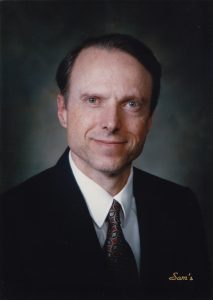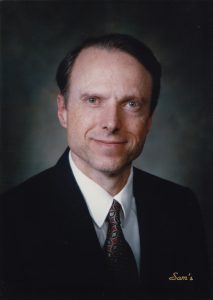Edward Boyle, December 22, 1999
 Published in the BAMC Beat (Brooke Army Medical Center) Vol.2, No.6, June 2002:
Published in the BAMC Beat (Brooke Army Medical Center) Vol.2, No.6, June 2002:
Doctor to be remembered at ribbon cutting
It almost seems fictional — too good to be true. The story of a man battling one of the most painful types of cancer and still managing to put in 12 hours of work a day. The story of a man who grabbed a pen and pencil, designed a women’s imaging section he knew BAMC needed and made sure those sketches came to life. The story of a man that, while on his deathbed, still managed to inspire others
Dr. Edward Boyle came to BAMC in 1995, seizing the opportunity to both teach and practice medicine, especially radiology. He dedicated himself to improving the quality and reputation of the mammography section, a place he knew wasn’t nearly as sensitive to women as it should be.
“He recognized the need to have this sensitive area of radiology separated,” said LTC (Dr.) John Black, who worked with Boyle for a few years. “It’s a very stressful time when you think you have breast cancer, and being in the same hallway with someone having their ankle x-rayed just isn’t sensitive. He knew that it needed a separate facility.”
Off On the Right Foot
Boyle was born in 1947 in New York City. Growing up, his interests in health and sciences were obvious. One time he even volunteered for the human trials of the polio vaccine. He also looked up to his grandfather, a doctor in the New York area who furthered his interests in becoming a doctor.
Boyle’s passion paid off. He graduated from Yale, and then graduated from medical school at State University of New York – Downstate in 1973. It was during medical school, on a flight back from Port Au Prince, Haiti, when something caught his eye – his future wife Marie Charles. They married in Haiti in 1971.
Before BAMC
After Boyle finished his residency program, he soon returned to Haiti to serve as Chief of Medicine at the Albert Schweitzer Hospital, established in the 1950 to provide public health improvements, vaccinations and medical care to the poor in the countryside of Haiti. Then he returned to the United States and established himself as a primary care physician. He then became interested in mammography and radiology, and in 1987 he sold his private practice and joined the radiology residency program at Ohio State University. At the age of 40, he returned to the life or a resident usually reserved for those nearly half his age. But he made it, completing the program in 1991.
He returned to private practice as a diagnostic radiologist in a few areas, but soon realized he loved teaching as much as practicing medicine. So in 1994, he found an opportunity to do both and concentrate on mammography at BAMC.
However, it was at this time, when Boyle finally found his calling, that things took a sharp and cruel turn. The man who devoted his life to breast cancer soon discovered he had pancreatic cancer. He went through two major surgeries in September and December of 1994 to remove it, but five years later, the cancer returned.
“This man had a terminal disease that takes most people within a year,” LTC Black said. “He lasted five years, and that whole five years instead of travelling the world or taking it easy and spending his money, he spent his time in this building making women’s imaging better here than it is in 99 percent of the United States.”
During those five years, Boyle reorganized the training programs for residents and staff at the medical center, serving as Chief of the Radiology Resident Training Program for SAUSHEC. At the research level, he participated in studies and prepared grant applications for research projects to be conducted at BAMC. He was the coordinator of the Digital Mammography Project, co-investigator of the premarket Digital Mammography Machine Project, co-wrote a published article, which was the first to investigate the effects of motion on the use of Digital Mammography, and he wrote the grant application for the Digital Screening Mammography Project that was commissioned by the NCI.
But the whole time he did all of that, his eyes stayed focused on a bigger prize.
His Final Accomplishment
At the time, mammography and breast ultrasounds were being done in the general radiology department. It wasn’t very private for women.
Then, Boyle noticed an old x-ray file room and knew it would be perfect for a new women’s imaging center.
So he sat down at a drawing board and sketched out his plans.
He then consulted with architects, engineers and other radiologists to see what would be optimum for BAMC. He wanted a higher level of mammography care. He wanted more then just outpatient screening. He wanted patients to be able to know right away if there’s a problem.
The whole time, however, he was battling a painful cancer.
“Quite often, during the day,” LTC Black said, “I’d find him in the bathroom just overcome with pain — he was also diabetic — trying to inject his pain medicine. And anyone with pancreatic cancer will tell you when the disease strikes, it is terribly painful. But as soon as he got the pain under control, he’d be back to the work area. He never cried, he never gave up, never said a negative word and he never asked, ‘why me?’”
LTC Black also emphasized that Boyle exemplified Army Leadership values, even though he was a civilian doctor.
In Boyle’s final weeks alive, he was stricken to a bed, knowing he would die soon. But his heart was strong. He allowed the residents to come visit him at his house when he was drinking water through a straw via a tube through his stomach. He would give away his medical books to the residents and sign them with inspirational notes. Then, at the age of 52, he died.
And now, three years after his death, his life will be remembered at the new mammography wing he spent the last years of his life building. And under his picture will be the words, “Dr. Edward Boyle, MD. Founder and Advocate of the Brooke Army Medical Center Women’s Imaging Center. Friend, Colleague, Teacher, Mentor. A Courageous Leader Who Put the Needs of his Patients and Students First.”
To LTC Black it was the least they could do for Boyle.
“He inspired people to the point where people still remember his actions years later, “ Black said. “And now it’s our turn to ensure he is not forgotten.”
[in_memoriam_closing]


Ed was one of my roommates in sophomore and senior year. Ed arrived at Yale as a devout Catholic, but the efforts of Seiver and Klugheit, and the Yale environment, gradually wore him down. He got his MD after graduation, but moved numerous times after. His death is a mystery. I did locate his son, but have been unable to talk to him. We may never know.
I did find and contact Ed’s son, and this is the result.